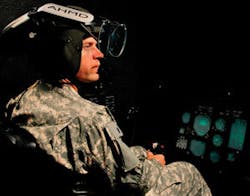A suite of helicopter simulators at the U.S. Army Flight School XXI (FSXXI) at the U.S. Army Aviation Warfighting Center in Fort Rucker, Ala., help to teach basic flight techniques to new student pilots and to provide advanced flight instruction to rated Army aviators. Administrators and professors at the facility wanted to infuse the simulators with the latest technology, for the benefit of new and seasoned military aviators.
They turned to L-3 Communications’ L-3 Link Simulation and Training (L-3 Link) division in Arlington, Texas. L-3 Link is integrating its advanced helmet-mounted display (AHMD) system into the FSXXI program’s reconfigurable collective training devices (RCTDs). This technology-insertion upgrade replaces existing helmet-mounted displays that have been used by U.S. Army aviators since 2005. This integration marks the first time L-3’s immersive visual display has been used in a military training-and-simulation program.
“L-3 Link’s Advanced Helmet Mounted Display, which provides pilots with a 360-degree field-of-regard of out-the-window imagery and systems symbology, will bring several training benefits to Flight School XXI reconfigurable collective training devices,” says Lenny Genna, L-3 Link’s vice president of Army Programs. “This display technology will improve visual resolution, enhance image quality, and provide greater transmissivity to enable aircrews to more realistically view their surrounding cockpit instrumentation.
“Helmet-mounted displays have proven their effectiveness in supporting the U.S. Army Aviation Warfighting Center’s conduct of large-scale, simulation-based aviation training exercises, which are conducted over geo-specific visual databases of areas in Iraq and Afghanistan to which units are preparing to deploy,” Genna continues. “The integration of L-3’s AHMDs into these exercises will enhance the quality and training realism of these major training events.”
To date, L-3 has delivered 11 RCTDs, which can be reconfigured to support simulated training in the UH-60A/L, CH-47D, OH-58D, AH-64A, and AH-64D aircraft. L-3 will deliver another seven units in December. In all, L-3 is providing 37 simulators and training devices to FSXXI.
L-3 Link also is providing FSXXI simulators and other contractor logistics support services under a subcontract with Computer Sciences Corporation, which serves as prime contractor on this U.S. Army aviation training program.
For more information, visit L-3 Link Simulation and Training online at www.link.com.




